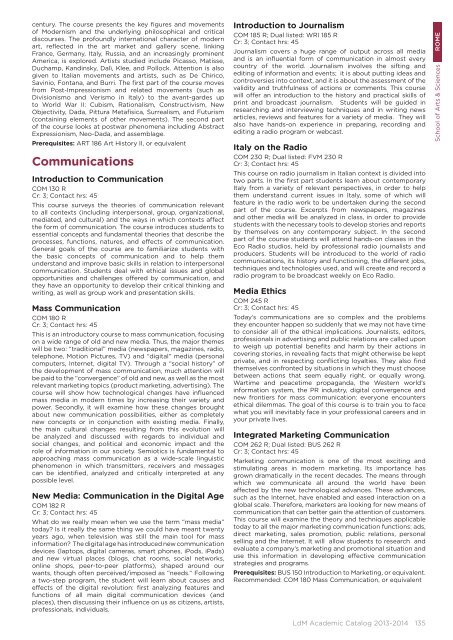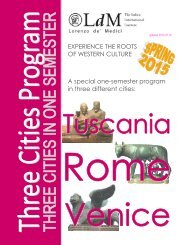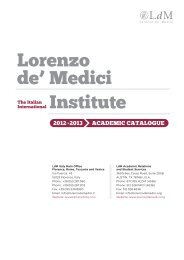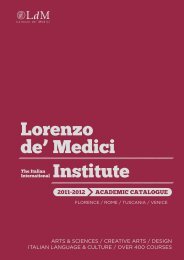aCademiC Catalog 2013-2014 - Lorenzo de Medici
aCademiC Catalog 2013-2014 - Lorenzo de Medici
aCademiC Catalog 2013-2014 - Lorenzo de Medici
You also want an ePaper? Increase the reach of your titles
YUMPU automatically turns print PDFs into web optimized ePapers that Google loves.
century. The course presents the key figures and movements<br />
of Mo<strong>de</strong>rnism and the un<strong>de</strong>rlying philosophical and critical<br />
discourses. The profoundly international character of mo<strong>de</strong>rn<br />
art, reflected in the art market and gallery scene, linking<br />
France, Germany, Italy, Russia, and an increasingly prominent<br />
America, is explored. Artists studied inclu<strong>de</strong> Picasso, Matisse,<br />
Duchamp, Kandinsky, Dalì, Klee, and Pollock. Attention is also<br />
given to Italian movements and artists, such as De Chirico,<br />
Savinio, Fontana, and Burri. The first part of the course moves<br />
from Post-Impressionism and related movements (such as<br />
Divisionismo and Verismo in Italy) to the avant-gar<strong>de</strong>s up<br />
to World War II: Cubism, Rationalism, Constructivism, New<br />
Objectivity, Dada, Pittura Metafisica, Surrealism, and Futurism<br />
(containing elements of other movements). The second part<br />
of the course looks at postwar phenomena including Abstract<br />
Expressionism, Neo-Dada, and assemblage.<br />
Prerequisites: ART 186 Art History II, or equivalent<br />
Communications<br />
Introduction to Communication<br />
COM 130 R<br />
Cr: 3; Contact hrs: 45<br />
This course surveys the theories of communication relevant<br />
to all contexts (including interpersonal, group, organizational,<br />
mediated, and cultural) and the ways in which contexts affect<br />
the form of communication. The course introduces stu<strong>de</strong>nts to<br />
essential concepts and fundamental theories that <strong>de</strong>scribe the<br />
processes, functions, natures, and effects of communication.<br />
General goals of the course are to familiarize stu<strong>de</strong>nts with<br />
the basic concepts of communication and to help them<br />
un<strong>de</strong>rstand and improve basic skills in relation to interpersonal<br />
communication. Stu<strong>de</strong>nts <strong>de</strong>al with ethical issues and global<br />
opportunities and challenges offered by communication, and<br />
they have an opportunity to <strong>de</strong>velop their critical thinking and<br />
writing, as well as group work and presentation skills.<br />
Mass Communication<br />
COM 180 R<br />
Cr: 3; Contact hrs: 45<br />
This is an introductory course to mass communication, focusing<br />
on a wi<strong>de</strong> range of old and new media. Thus, the major themes<br />
will be two: “traditional” media (newspapers, magazines, radio,<br />
telephone, Motion Pictures, TV) and “digital” media (personal<br />
computers, Internet, digital TV). Through a “social history” of<br />
the <strong>de</strong>velopment of mass communication, much attention will<br />
be paid to the “convergence” of old and new, as well as the most<br />
relevant marketing topics (product marketing, advertising). The<br />
course will show how technological changes have influenced<br />
mass media in mo<strong>de</strong>rn times by increasing their variety and<br />
power. Secondly, it will examine how these changes brought<br />
about new communication possibilities, either as completely<br />
new concepts or in conjunction with existing media. Finally,<br />
the main cultural changes resulting from this evolution will<br />
be analyzed and discussed with regards to individual and<br />
social changes, and political and economic impact and the<br />
role of information in our society. Semiotics is fundamental to<br />
approaching mass communication as a wi<strong>de</strong>-scale linguistic<br />
phenomenon in which transmitters, receivers and messages<br />
can be i<strong>de</strong>ntified, analyzed and critically interpreted at any<br />
possible level.<br />
New Media: Communication in the Digital Age<br />
COM 182 R<br />
Cr: 3; Contact hrs: 45<br />
What do we really mean when we use the term “mass media”<br />
today? Is it really the same thing we could have meant twenty<br />
years ago, when television was still the main tool for mass<br />
information? The digital age has introduced new communication<br />
<strong>de</strong>vices (laptops, digital cameras, smart phones, iPods, iPads)<br />
and new virtual places (blogs, chat rooms, social networks,<br />
online shops, peer-to-peer platforms), shaped around our<br />
wants, though often perceived/imposed as “needs.” Following<br />
a two-step program, the stu<strong>de</strong>nt will learn about causes and<br />
effects of the digital revolution: first analyzing features and<br />
functions of all main digital communication <strong>de</strong>vices (and<br />
places), then discussing their influence on us as citizens, artists,<br />
professionals, individuals.<br />
Introduction to Journalism<br />
COM 185 R; Dual listed: WRI 185 R<br />
Cr: 3; Contact hrs: 45<br />
Journalism covers a huge range of output across all media<br />
and is an influential form of communication in almost every<br />
country of the world. Journalism involves the sifting and<br />
editing of information and events; it is about putting i<strong>de</strong>as and<br />
controversies into context, and it is about the assessment of the<br />
validity and truthfulness of actions or comments. This course<br />
will offer an introduction to the history and practical skills of<br />
print and broadcast journalism. Stu<strong>de</strong>nts will be gui<strong>de</strong>d in<br />
researching and interviewing techniques and in writing news<br />
articles, reviews and features for a variety of media. They will<br />
also have hands-on experience in preparing, recording and<br />
editing a radio program or webcast.<br />
Italy on the Radio<br />
COM 230 R; Dual listed: FVM 230 R<br />
Cr: 3; Contact hrs: 45<br />
This course on radio journalism in Italian context is divi<strong>de</strong>d into<br />
two parts. In the first part stu<strong>de</strong>nts learn about contemporary<br />
Italy from a variety of relevant perspectives, in or<strong>de</strong>r to help<br />
them un<strong>de</strong>rstand current issues in Italy, some of which will<br />
feature in the radio work to be un<strong>de</strong>rtaken during the second<br />
part of the course. Excerpts from newspapers, magazines<br />
and other media will be analyzed in class, in or<strong>de</strong>r to provi<strong>de</strong><br />
stu<strong>de</strong>nts with the necessary tools to <strong>de</strong>velop stories and reports<br />
by themselves on any contemporary subject. In the second<br />
part of the course stu<strong>de</strong>nts will attend hands-on classes in the<br />
Eco Radio studios, held by professional radio journalists and<br />
producers. Stu<strong>de</strong>nts will be introduced to the world of radio<br />
communications, its history and functioning, the different jobs,<br />
techniques and technologies used, and will create and record a<br />
radio program to be broadcast weekly on Eco Radio.<br />
Media Ethics<br />
COM 245 R<br />
Cr: 3; Contact hrs: 45<br />
Today’s communications are so complex and the problems<br />
they encounter happen so sud<strong>de</strong>nly that we may not have time<br />
to consi<strong>de</strong>r all of the ethical implications. Journalists, editors,<br />
professionals in advertising and public relations are called upon<br />
to weigh up potential benefits and harm by their actions in<br />
covering stories, in revealing facts that might otherwise be kept<br />
private, and in respecting conflicting loyalties. They also find<br />
themselves confronted by situations in which they must choose<br />
between actions that seem equally right, or equally wrong.<br />
Wartime and peacetime propaganda, the Western world’s<br />
information system, the PR industry, digital convergence and<br />
new frontiers for mass communication: everyone encounters<br />
ethical dilemmas. The goal of this course is to train you to face<br />
what you will inevitably face in your professional careers and in<br />
your private lives.<br />
Integrated Marketing Communication<br />
COM 262 R; Dual listed: BUS 262 R<br />
Cr: 3; Contact hrs: 45<br />
Marketing communication is one of the most exciting and<br />
stimulating areas in mo<strong>de</strong>rn marketing. Its importance has<br />
grown dramatically in the recent <strong>de</strong>ca<strong>de</strong>s. The means through<br />
which we communicate all around the world have been<br />
affected by the new technological advances. These advances,<br />
such as the Internet, have enabled and eased interaction on a<br />
global scale. Therefore, marketers are looking for new means of<br />
communication that can better gain the attention of customers.<br />
This course will examine the theory and techniques applicable<br />
today to all the major marketing communication functions: ads,<br />
direct marketing, sales promotion, public relations, personal<br />
selling and the Internet. It will allow stu<strong>de</strong>nts to research and<br />
evaluate a company’s marketing and promotional situation and<br />
use this information in <strong>de</strong>veloping effective communication<br />
strategies and programs.<br />
Prerequisites: BUS 150 Introduction to Marketing, or equivalent.<br />
Recommen<strong>de</strong>d: COM 180 Mass Communication, or equivalent<br />
School of Arts & Sciences ROME<br />
LdM Aca<strong>de</strong>mic <strong>Catalog</strong> <strong>2013</strong>-<strong>2014</strong><br />
135





